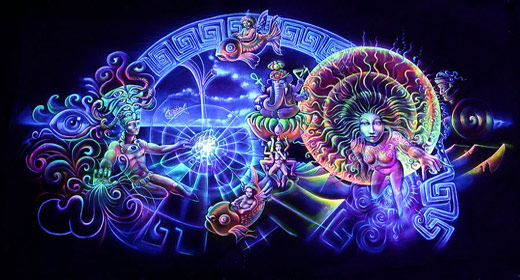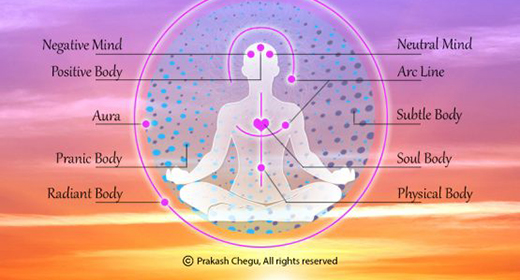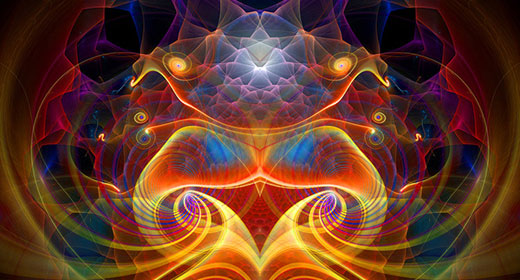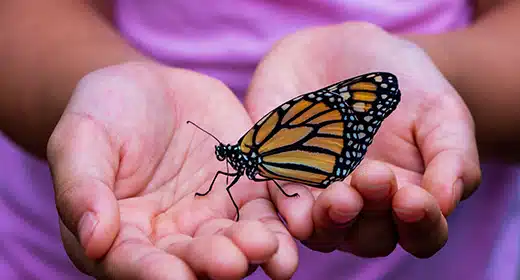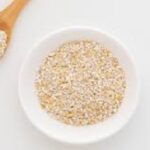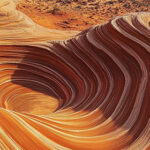by Dr. Alberto Villoldo: The shaman is trained to see the invisible world of energy and spirit. With practice, you too can develop this skill…

In earlier blog posts we covered connecting the heart chakra and the third eye to the visual cortex and engaging your inner perception. Today we start with an exercise to free kinesthetic sense.
The Second Attention practice is an eye movement exercise that resets our sensory coordinates to zero. Otherwise our sensory perception remains locked into the first attention, the tunnel vision of ordinary reality.
In this initial exercise, we will use the Second Attention practice to free our kinesthetic sense and perceive the acupuncture meridians. Once you can feel energy, you can translate this sensation into an image through synesthesia.
Exercise: The Second Attention
Imagine that your eyes are the face of a clock. The eyes act like a pointing device and signal the region of our brain we employ for different mental activity. For example, many right-handed people look toward ten o’clock when performing mathematical computations, and toward two o’clock when recalling their favorite songs. Check this out with a coworker or friend. Ask them to add 27 plus 19, then observe in which direction they turn their eyes. Everyone responds differently, yet their eyes always point in the same direction every time. Now ask them to recall the smell of freshly baked bread, or a song. observe which direction their eyes point toward. These are the perceptual coordinates of the first attention, of ordinary reality.
The Second Attention practice involves rotating your eyes with your eyelids shut to clear the perceptual screen. Close your eyes and move them (without moving your head) from left to right, up to down, upper left to lower right, and vice versa. Now rotate your eyes in a big circle, left to right three times and then right to left three times. Repeat once more, rotating your eyes in small circles, eyelids shut.
Bring your hands together in the prayer pose. (The ten principal acupuncture meridians run throughout the body, passing through the hands and fingertips, and when we bring our hands together in a prayer pose we balance the energies that flow through the acupuncture meridians.) Be sure that there is a little space between the fingers of each hand and that the fingertips are touching each other, index to index, thumb to thumb, and so forth. Your hands should be resting gently against your chest. Take a few deep breaths while holding your hands together.
Next, separate your hands and shake them vigorously from side to side for about thirty seconds, relaxing and allowing them to become limp. Bring your hands together again in the prayer pose. Gradually separate your palms, keeping your fingertips together. Be aware of the feeling in your hands. Do they feel cool? Warm? Do you sense a slight electrical sensation between your palms? Separate your hands slowly, remaining aware of your fingertips. Do you feel tingling in the pads at the tips of your fingers? See how far you can separate your fingers and still maintain that tingling or electrical sensation. Imagine that you can sense the luminous threads that connect your fingertips to each other. These are extensions of the acupuncture meridians.
Practice this a few times until you can sense your meridians with your hands twelve inches apart. Notice which hand is more sensitive. Can you sense the energy better with you left or your right fingertips?
Exercise: Sensing the Luminous Energy Field
Next, we want to learn to scan the membrane of the Luminous Energy Field. In a standing position, close your eyes and do the Second Attention practice. Become aware of your breathing. Zen meditators attend to the breath to keep the rational mind engaged while they explore other domains with their awareness.
Shake your hands vigorously for a few seconds and bring them together in the prayer pose. Slowly turn your hands so that your palms are facing out, away from the body. Gradually fan out your hands until they are about a foot away from your belly. Move your hands back and forth slowly, as if you were wiping a window clean, and try to sense the inner membrane or skin of the Luminous Energy Field. Is it smooth, or does it have a texture? Is it elastic, does it yield, or is it firm? Does it feel warm or cool? Can you push it out and expand it? (ln the city the Luminous Energy Field is drawn tightly around us like a silk cocoon, while after a few days in nature it expands to the width of our outstretched arms.) Are there ridges and pockets in it? These usually indicate places where our luminous membrane is weak and where we leak energy or can be penetrated by energies and emotions belonging to others. Imagine the color of your Luminous Energy Field.
When you’re done, return your hands to prayer pose for a few breaths to balance your energy. Practice this exercise until you are able to clearly sense the texture and feel of the membrane of your Luminous Energy Field.
Exercise: Reading the Chakras
We will use a similar exercise to sense the chakras. In this exercise we will work with the each of the Earth chakras. Repeat the Second Attention practice; shake your hands vigorously for a few seconds and bring them to prayer pose. Remain mindful of your breath.
Now bring the palms of your open hands about three inches below your navel, very close to your skin. Stay with your breath. Imagine your chakras as funnels of energy, spinning just outside your skin like whirlpools of light. The outer lip of the funnel lies three to four inches outside the body, while much of the length of the chakra resides within the body. Find the outer edge of the funnel of your second chakra. Sense its circumference and the energy whirling within it. When I place a finger in a chakra I sense the energy like cool water swirling past my fingertip.
Gradually bring your index finger into the chakra, going in toward the body. What does it feel like? Is it cool, warm, or neutral? Bring your attention to the very tip of your finger and sense what you feel on the pad. Is it tingly, soft, or rough? The belly chakra is associated with the fight-or-flight response. When we experience fear or danger, we immediately register it in this chakra. While you explore your second chakra with the tip of your finger, recall when you last felt afraid. Do you notice a difference in the feel and texture? Everyone senses energy differently. What you register as icy someone else might sense as warm. The second chakra is the easiest to read, as it is the seat of our passions and emotions, and holds a high charge. Repeat the exercise with the first chakra. Notice if the texture and density of the chakra changes when you recall a time when you felt safe and protected, perhaps when you were young. Now recall a time when you did not feel safe, or when you woke up from a nightmare. How is the energy different?
Now try sensing the third chakra. Recall a time when you were acknowledged and recognized for an achievement. Does the texture of the energy seem to change? Recall a time you felt ashamed. Now move up to the fourth chakra. Recall when you were in love, when you first met your spouse or partner. Now recall a time you felt abandoned or heartbroken. Notice the changes in the quality of the energy. Next try sensing the fifth chakra. Recall a time when you experienced great inner peace, perhaps during meditation. Now recall a time you felt you were not heard by a loved one. How is the energy different?
Until now, we have been working with quantitative measures. The exercises you’ve done thus far give you a sense of the texture and intensity of the energy in the chakras. Most healers do not get beyond this stage. They feel the strength and weakness of the energy and nothing more. We want to develop the next stage, the qualitative measures. What information does the energy contain? What are the stories, the joy and the pain? We achieve this through the Second Awareness. The Second Attention practice frees your sensory systems, the Second Awareness, which we’ll cover in a future blog post, allows you to read the stories contained in energy.


